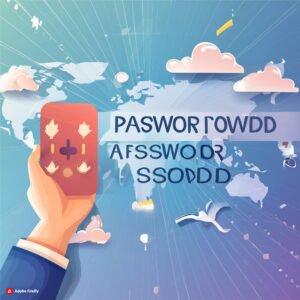Password Power: Safeguarding Your Digital Identity Made EasyIn an age where our lives are increasingly intertwined with the digital realm, the importance of strong passwords cannot be overstated. Whether you’re logging into your email, accessing online banking services, or managing your social media accounts, your password serves as the first line of defense against unauthorized access and potential cyber threats. In this comprehensive guide, we’ll delve into the significance of strong passwords, explore best practices for creating and managing them, and highlight the tools available to enhance your digital security.
Why Strong Passwords Matter
Passwords are the keys to our digital kingdom, granting access to sensitive information and personal data. Weak or easily guessable passwords are akin to leaving the front door of your house unlocked, inviting cybercriminals to exploit vulnerabilities and compromise your digital identity. With the prevalence of automated hacking tools and sophisticated phishing techniques, the stakes have never been higher for securing your online accounts with robust passwords.

Characteristics of a Strong Password
A strong password is one that is difficult for others to guess or crack through brute force methods. Here are some essential characteristics of a strong password:
- Length: Aim for a minimum of 12 characters, with longer passwords being even more secure.
- Complexity: Include a combination of uppercase and lowercase letters, numbers, and special characters.
- Unpredictability: Avoid using easily guessable information such as your name, birthdate, or common dictionary words.
- Uniqueness: Use a different password for each of your accounts to prevent a single breach from compromising multiple accounts.
Tips for Creating Strong Passwords
Creating strong passwords doesn’t have to be complicated. Here are some tips to help you craft robust passwords that are both secure and memorable:
- Passphrase Approach: Consider using a passphrase instead of a single word, combining multiple words or phrases to create a longer, more complex password. For example, “BlueElephant$Jumping#OverTheMoon” is much stronger than a single word or phrase.
- Randomization: Use a random combination of letters, numbers, and symbols that don’t form recognizable patterns or words. You can use password generators or mnemonic techniques to create memorable yet secure passwords.
- Substitutions: Replace certain letters with numbers or symbols to add complexity to your password. For example, “P@ssw0rd” instead of “Password” or “S3cur1ty” instead of “Security”.
- Avoid Common Patterns: Steer clear of predictable patterns such as consecutive numbers or keyboard sequences (e.g., “123456” or “qwerty”).
- Memorability: Choose a password that is easy for you to remember but difficult for others to guess. You can create memorable passwords by incorporating personal information that is meaningful to you but not easily accessible to others.
Best Practices for Managing Passwords
Creating strong passwords is only the first step. Effective password management is equally important to ensure the security of your accounts. Here are some best practices for managing your passwords:
- Use a Password Manager: Consider using a reputable password manager to securely store and manage your passwords. Password managers offer features such as password generation, auto-fill, and synchronization across devices, making it easy to maintain strong and unique passwords for all your accounts.
- Enable Two-Factor Authentication (2FA): Add an extra layer of security to your accounts by enabling two-factor authentication wherever available. This requires users to provide a second form of verification, such as a one-time code sent to their phone, in addition to their password.
- Regularly Update Your Passwords: Periodically change your passwords, especially for accounts that contain sensitive information or are critical to your digital identity. Aim to update your passwords at least every six months to mitigate the risk of credential-based attacks.
- Be Wary of Phishing Attempts: Exercise caution when clicking on links or downloading attachments from unknown or suspicious emails. Cybercriminals often use phishing emails to trick users into revealing their passwords or other sensitive information. Look out for red flags such as misspelled URLs, urgent requests for personal information, or unsolicited attachments.
- Stay Informed: Stay informed about the latest cybersecurity threats and best practices for password security. Follow reputable cybersecurity blogs, news sources, and official advisories from security organizations to stay up-to-date on emerging threats and trends.
Common Examples of Weak Passwords
To illustrate the importance of strong passwords, let’s take a look at some common examples of weak passwords that should be avoided:
- “Password”: This is perhaps the most commonly used password and is extremely easy for attackers to guess.
- “123456”: A sequence of consecutive numbers is highly predictable and offers little protection against brute force attacks.
- “qwerty”: Using keyboard sequences as passwords is risky as they are easily guessable.
- “letmein”: This phrase is often attempted by attackers and provides little security against unauthorized access.
- “iloveyou”: While sentimental, passwords based on common phrases or sentiments are easily guessed by attackers.
By avoiding these common pitfalls and following the best practices outlined in this guide, you can create strong, secure passwords that protect your digital identity and safeguard your online accounts against cyber threats.
Conclusion
In an era of heightened cybersecurity risks, the importance of strong passwords cannot be overstated. By creating robust passwords and following best practices for password management, you can significantly enhance your digital security and protect your online accounts from unauthorized access and potential cyber threats. Remember, your password is the first line of defense in safeguarding your digital identity – make it strong, make it unique, and make it yours.
Leave a Reply